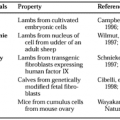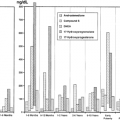GENE STRUCTURE
Polypeptide hormones may be encoded by single or multiple genes. Frequently, a hormone requires only intramolecular folding and formation of disulfide linkages in a single protein backbone to form the bioactive molecule. Sometimes, the bioactive hormone is formed by the covalent or noncovalent association of two or more subunits derived from a single gene or multiple genes. An example of the former is insulin, which is initially synthesized as a precursor with polypeptide subunits A and B interrupted by peptide C. However, during its intracellular processing, disulfide linkages are formed between subunits A and B, with the proteolytic cleavage and removal of peptide C. Two subunits are associated in a covalent manner to yield the bioactive insulin molecule. Major examples of the latter case are glycoprotein hormones (i.e., TSH and gonadotropins) (see Chap. 15 and Chap. 16). In this family of hormones, each member consists of two subunits encoded by separate genes located on separate chromosomes. The subunits become associated in a noncovalent manner to form the bioactive dimer.5
Several hormones require proteolytic cleavage of the precursor molecule before the formation of the bioactive product. The major example is adrenocorticotropic hormone (ACTH) and β-lipotropin produced from the precursor preproopiomelanocortin by trypsin-like proteolytic cleavage at dibasic residues. Each polypeptide may require covalent modifications of its polypeptide backbone. In the glycoprotein hormones, each subunit contains several N-linked carbohydrate moieties, and the β subunit of human chorionic gonadotropin contains additional O-linked oligosaccharides. In yet other molecules, the addition of sulfate, phosphate, acetyl, and COOH-amide groups is necessary for full bioactivity. Bioactive peptides found in the brain-gut axis require a COOH-terminal amide group for full activity. This conversion is catalyzed by an α-amidation enzyme on substrate hormones that possess COOH-terminal sequences: X-Y-Gly →X-Y-NH2.6,7
The gene that encodes the polypeptide hormone is part of a simple or complex transcriptional unit. A simple transcriptional unit (Fig. 3-4) is composed of two major components: structural and regulatory. A simple unit produces a single mRNA, whereas a complex unit may yield multiple mRNAs, some of which may encode different proteins. The structural region encodes information that is ultimately found in mRNA (Fig. 3-5). However, in most eukaryotic genes, the coding region is not contiguous with that in the mRNA. Intervening or extraneous segments of DNA are placed between regions that eventually are found in mature mRNA. The coding regions in genes that are ultimately found in mRNA are known as exons, and the intervening sequences are known as introns. The role and function of introns are unknown, although introns separate functional domains in many polypeptides.8 A similar exon encoding an epidermal growth factor (EGF)–like domain has been detected in genes encoding the low-density lipoprotein receptor, the precursor of EGF, and clotting factors IX and X.9 These and other data suggest that introns may play important roles in the evolution of protein families. Moreover, introns may participate in alternate splicing of exons, leading to increased mRNA and polypeptide diversity.
 FIGURE 3-5. The structural region of the transcriptional unit. The structural region contains DNA information that is completely copied and transcribed into the heterogeneous nuclear RNA or RNA precursor. The important feature of eukaryotic structural regions of the gene is the presence of exons and introns. The exon contains sequences that are retained in the mature messenger RNA; the intron sequences are removed during RNA splicing in the nucleus. The first nucleotide of the structural region is known as the cap site, which is the point at which transcription begins in the first exon. The structural region terminates at the polyadenylation site, which is determined in part by the presence of a polyadenylation signal, AATAAA, located 15 to 20 nucleotides upstream of the polyadenylation site.
Stay updated, free articles. Join our Telegram channel
Full access? Get Clinical Tree
 Get Clinical Tree app for offline access
Get Clinical Tree app for offline access

|





